
Year 1041 (MXLI) was a common year starting on Thursday of the Julian calendar.
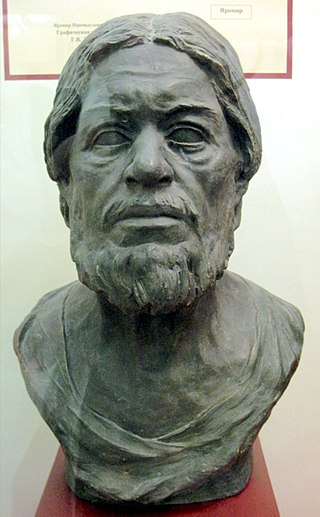
Samuel was the Tsar (Emperor) of the First Bulgarian Empire from 997 to 6 October 1014. From 977 to 997, he was a general under Roman I of Bulgaria, the second surviving son of Emperor Peter I of Bulgaria, and co-ruled with him, as Roman bestowed upon him the command of the army and the effective royal authority. As Samuel struggled to preserve his country's independence from the Byzantine Empire, his rule was characterized by constant warfare against the Byzantines and their equally ambitious ruler Basil II.

Michael IV the Paphlagonian was Byzantine Emperor from 11 April 1034 to his death on 10 December 1041.

The Kometopuli dynasty was the last royal dynasty in the First Bulgarian Empire, ruling from c. 976 until the fall of Bulgaria under Byzantine rule in 1018. The most notable member of the dynasty, Tsar Samuel, is famous for successfully resisting Byzantine conquest for more than 40 years. Sometimes the realm of the Cometopuli is called Western Bulgarian Kingdom or Western Bulgarian Empire.
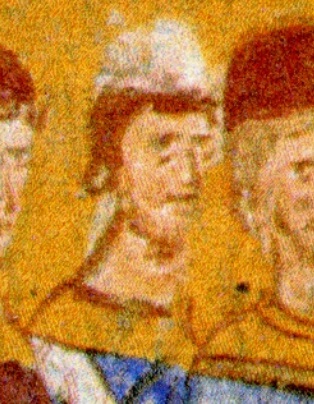
Gavril Radomir was the Emperor (Tsar) of the First Bulgarian Empire from October 1014 to August or September 1015. He was the son of tsar Samuel.
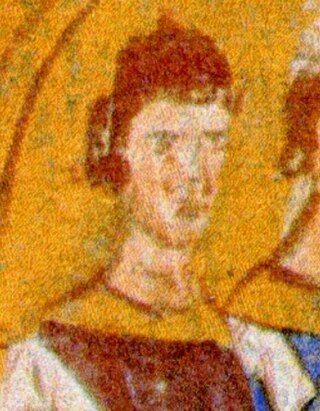
Ivan Vladislav served as the emperor (tsar) of the First Bulgarian Empire from approximately August or September 1015 until February 1018. The precise year of his birth remains elusive; he was born at least ten years prior to 987, but likely not much earlier than that.
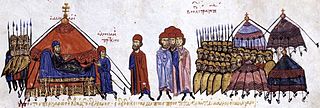
Alusian was a Bulgarian and Byzantine noble who ruled as emperor (tsar) of Bulgaria for a short time in 1041.
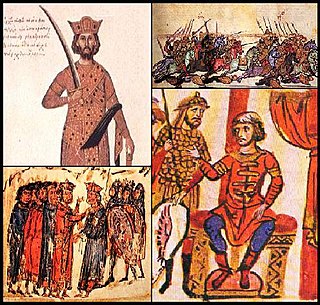
The Byzantine–Bulgarian wars were a series of conflicts fought between the Byzantine Empire and Bulgaria which began after the Bulgars conquered parts of the Balkan peninsula after 680 AD. The Byzantine and First Bulgarian Empire continued to clash over the next century with variable success, until the Bulgarians, led by Krum, inflicted a series of crushing defeats on the Byzantines. After Krum died in 814, his son Omurtag negotiated a thirty-year peace treaty. Simeon I had multiple successful campaigns against the Byzantines during his rule from 893 to 927. His son Peter I negotiated another long-lasting peace treaty. His rule was followed by a period of decline of the Bulgarian state.
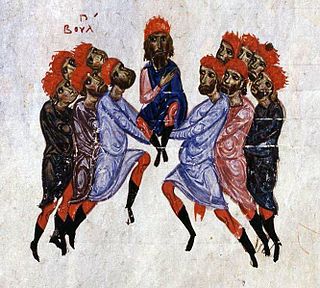
The Uprising of Petar Delyan, which took place in 1040–1041, was a major Bulgarian rebellion against the Byzantine Empire in the Theme of Bulgaria. It was the largest and best-organised attempt to restore the former Bulgarian Empire until the rebellion of Ivan Asen I and Petar IV in 1185.
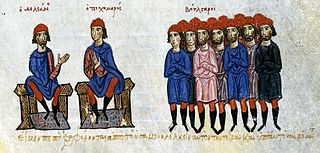
Tihomir was an 11th-century Bulgarian military commander of Dyrrhachium, who had been sent to tackle an uprising in the north headed by the Bulgarian noble Peter Delyan. He defected and joined him, but later came into conflict with Delyan because he had his own claim to the throne.

The battle of Thessalonica occurred in 1040 near the city of Thessalonica in contemporary Greece between the Bulgarians and the Byzantines. The battle ended with a Bulgarian victory.

The battle of Thessalonica took place in the fall of 1040 near the city of Thessalonica in contemporary Greece between the Bulgarians and the Byzantines. The battle ended with a Byzantine victory.

Delyan is a village in the Sofia Province, western Bulgaria, near the town of Breznik. The old historic name of the village is Karnul. As of 2007, the village has only 18 permanent inhabitants. Delyan is located in the municipality of Bozhurishte, 34 km west of Sofia on the eastern slopes of Viskyar Mountain with an average altitude of 790 meters. Its houses are nestled in a valley between three small peaks of Viskyar. It is named after the leader of the Bulgarian uprising against the Byzantine Empire (1040-1041) and for a short time Tsar (Emperor) of Bulgaria, Peter II Delyan. Administratively, the village is connected to the nearby village Zlatusha to which there is a tarmac road, built in early 1970s. It is close to the railroad Pernik-Voluyak, on the border between Sofia Province and Pernik Province, and nearby Dogandjia (Falconer), a remote neighborhood of Goz is in the Breznik Municipality. The village consists of 3 neighborhoods (mahali): Matsina and Rebrachka Mahala to the north of center, and Vanchina Mahala to the south of center. The church of St Mary, funded and built by local people on a hill near Delyan, was opened in the spring of 2008. To the south-west of Delyan, in the locality Ormana, there is a pine forest, planted in the 1970s. During favorable seasons, one can find there edible mushrooms, like saffron milk cap and sticky bun. Delyan is the birthplace of the writer Spas Antonov.

The Theme of Bulgaria was a province of the Byzantine Empire established by Emperor Basil II after the conquest of Bulgaria in 1018. Its capital was Skoupoi and it was governed by a strategos. The theme of Bulgaria did not encompass the old Bulgarian lands between the Haimos Mountains and the river Danube, that included the former capitals Pliska and Preslav. This territory was administred independently and was considered as autonomous military unit, designated as Paristrion or Paradunavon, meaning the "lands beside the Danube".

The Uprising of Georgi Voyteh was a Bulgarian uprising in the Byzantine theme of Bulgaria in 1072. It was the second major attempt to restore the Bulgarian Empire after the Uprising of Peter Delyan in 1040-1041.
The territory of modern Albania was part of the Bulgarian Empire during certain periods in the Middle Ages and some parts in what is now eastern Albania were populated and ruled by the Bulgarians for centuries. Most of Albania became part of the First Empire in the early 840s during the reign of Khan Presian. Some coastal towns such as Durrës remained in the hands of the Byzantines for most of that period. The castles of the inner mountainous country remained one of the last Bulgarian strongholds to be conquered by the Byzantines in 1018/1019 during the fall of the First Bulgarian Empire — Tomornitsa. During the Byzantine rule Albania was one of the centres of a Uprising of Peter Delyan. The last Bulgarian Emperor to govern the whole territory was Ivan Asen II (1218–1241) but after his successors the Bulgarian rule diminished. Much of that area corresponded with the Bulgarian historical region Kutmichevitsa.

From c. 970 until 1018, a series of conflicts between the Bulgarian Empire and the Byzantine Empire led to the gradual reconquest of Bulgaria by the Byzantines, who thus re-established their control over the entire Balkan peninsula for the first time since the 7th-century Slavic invasions. The struggle began with the incorporation of eastern Bulgaria after the Russo-Byzantine War (970–971). Bulgarian resistance was led by the Cometopuli brothers, who – based in the unconquered western regions of the Bulgarian Empire – led it until its fall under Byzantine rule in 1018.
Maria was the last empress consort (tsaritsa) of the First Bulgarian Empire. She was the wife of Tsar Ivan Vladislav of Bulgaria and was involved in political manoeuvring.

Petar Delyan, sometimes enumerated as Petar II, was the leader of a major Bulgarian uprising against Byzantine rule in the Theme of Bulgaria during the summer of 1040. He was proclaimed Tsar of Bulgaria, as Samuel's grandson in Belgrade, then in the theme of Bulgaria. His original name may have been simply Delyan, in which case he assumed the name Petar II upon accession, commemorating the sainted Emperor Petar I, who had died in 970. The exact year of his birth cannot be ascertained with certainty, but it is believed to have taken place during the early 11th century, likely between 1000 and 1014. Similarly, the year of his death is estimated to be 1041.
Aaron was a younger son of the last Tsar of the First Bulgarian Empire, Ivan Vladislav. After the Byzantine conquest of Bulgaria he entered Byzantine service along with his brothers, and held a series of higher military commands in the eastern provinces of the Byzantine Empire during the 1040s and 1050s, rising from patrikios to protoproedros in the process. In this capacity, he fought in the first battles against the invading Seljuq Turks, as well as, unsuccessfully, against the uprising in 1057 of his brother-in-law Isaac I Komnenos. The Aaronios noble family was named after him, and included his descendants, as well as the descendants of his siblings.


















